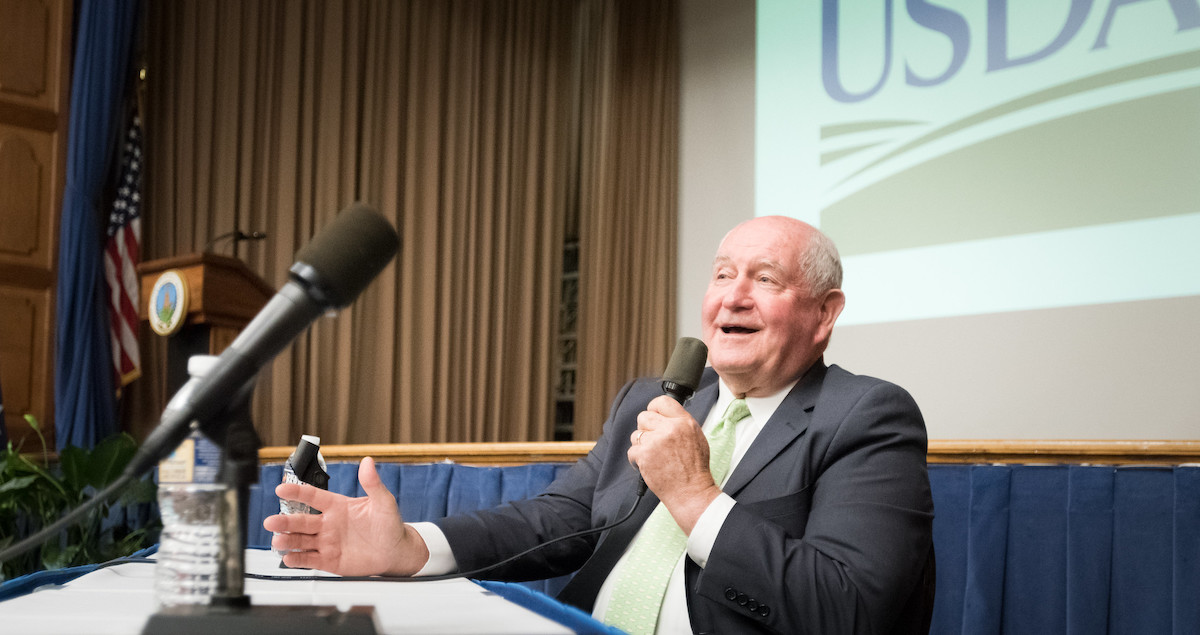A controversial relocation hollowed out ERS, USDA’s brain trust for food policy. This could spell dire consequences for food access and security.
In May, economist Claudia Hitaj and three of her colleagues published a report calculating the environmental costs and benefits of healthier eating. If Americans collectively cut down on sugar and meat, while boosting their fruit and vegetable intake—how would that affect the natural resources America uses to grow, process, and deliver food? Would our soil be healthier? Would we pollute more air?
Here’s what the authors found: Had the average American diet in 2007 been more closely aligned with federal nutrition standards, the food system would have required significantly fewer fossil fuels annually and freed up hundreds of millions of acres of farmland. On the other hand, it would have sucked up billions of gallons more fresh water. Greenhouse gas emissions would have remained roughly the same.
The findings suggest that it may be possible for U.S. farms to produce food in a more environmentally sustainable manner, while better meeting Americans’ nutritional needs. This research was timely, given the ongoing, cataclysmic effects of climate change, but it also raised more questions than answers. “We were going to do [follow-up] research that would try to identify trade-offs between different environmental impacts,” Hitaj said in a recent interview.
Policymakers and legislators use the information ERS produces to continually shape and reshape the country’s food system.
That research may never see the light of day. The report was published by a federal agency called the Economic Research Service (ERS)—a subagency of the Department of Agriculture (USDA) whose work has inescapable significance for anyone who grows, sells, or eats food in America. One year ago, the Trump administration relocated ERS out of its offices in the Beltway, forcing a large number of staffers to resign. Two of the report’s authors, including Hitaj, left the agency during this time.
Founded in 1961, the ERS mission is to conduct a wide breadth of analysis on the U.S. food system, as well as to serve as a warning signal, alerting policymakers of potential future disruptions to the food supply, such as climate change. Policymakers and legislators use the information ERS produces to continually shape and reshape the country’s food system, with the ultimate aim of keeping food flowing and affordable, and its production sustainable in the long-term.
[Subscribe to our 2x-weekly newsletter and never miss a story.]
In the past few years, however, the Trump administration made repeated attempts to dismantle ERS, an agency whose findings regularly contested Republican messaging. Those efforts culminated in a mass resignation of staff last September, just three months after USDA announced that it would relocate the agency to the Kansas City Metro Area. (An inspector general report later found that it had done so without the legally required Congressional approval.)
Hitaj didn’t want to leave D.C. for Kansas City, and she wasn’t alone: While ERS has funding for a total of 329 positions, in the one-year period following May 2019, active vacancies at the agency more than quadrupled from 24 to 97, topping out at 111 in January 2020, according to numbers obtained through public records requests. These numbers are likely a significant underestimate of the agency’s total loss: In response to a request for comment, a spokesperson said that the agency employed 172 permanent staffers as of mid-August—that means almost half of ERS’s positions remain unoccupied.
“Ultimately, a lot more people left than I—even in my worst case scenario—had imagined,” Hitaj said.
In Hitaj’s case, the publication of her team’s report was so delayed by the upheaval that by the time it came out, she had already resigned from ERS and had been working in the private sector for nine months. Her plans to conduct follow-up research on environmental trade-offs have long been scrapped.
Since the move, the agency has lost decades of expertise on a wide range of subjects, from climate change to antibiotic resistance, from rural economies to organic farming, leaving numerous projects in limbo and severely bottlenecking new research. Today, conversations between The Counter and more than 20 former and current ERS employees reveal that staff morale has plummeted. Many also assert that the agency is failing to live up to its mission due to severe understaffing and lack of stable leadership.
In effect, the past year has seen a hollowing out of the brain trust behind America’s food system. Policy makers depend on ERS to make sense of what is and isn’t working about the way we produce, market, and access food—information used to then inform policies that address challenges within the food system, from climate change to the Covid-19 pandemic. Now, as one sustainable farming advocate put it, those steering our food system may as well be “asleep at the wheel.”
“What a wonderful way to streamline government.”
The Trump administration made clear its intention to curtail ERS’s work early on. In March of 2017, the White House published a snapshot of its budget priorities, featuring a proposal to slash funding for the agency by about ten percent, and directly taking aim at its research on drought resilience, renewable energy, and food access, according to agency notes. Congress rejected the proposed cuts.
In 2018, the administration doubled down on its previous efforts, proposing to halve ERS’s budget and reduce its staff by 55 percent. It failed to secure Congressional approval again. But later in the year, USDA leadership announced ostensibly unrelated plans to relocate ERS—along with a sister agency called the National Institute of Food and Agriculture (NIFA) that administers $1.7 billion in research funding at land grant universities—out of Washington, D.C. Publicly, the decision was framed as a measure that would cut costs, bring researchers closer to producers, and more effectively recruit new staff. Privately, one high-ranking official seemed to confirm what ERS staffers suspected: If Congress didn’t defund the agency, relocation might be an alternative means to the same end.
“I thought I was a hardened civil servant, but I wasn’t quite prepared for this level of deceit.”
“It’s nearly impossible to fire a federal worker,” said Mick Mulvaney, then director of the Office of Management and Budget and currently acting White House chief of staff, at a GOP gala, referring to ERS and NIFA’s relocations. “I know that because a lot of them work for me. And I’ve tried. And you can’t do it. But simply saying to the people, you know what, we’re going to take you outside the bubble, outside the Beltway, outside this liberal haven and move you out into the real part of the country, and they quit. What a wonderful way to streamline government and do what we haven’t been able to do for a long time.”
In effect, the administration accomplished on its own what it could never convince Congress to permit. (More recently, it has attempted to perform a similar maneuver with the Bureau of Land Management.)
“I thought I was a hardened civil servant, but I wasn’t quite prepared for this level of deceit,” said Kelly Rubenstein, a former ERS staffer who took early retirement last September. “What a way to get rid of us—it was brilliant.”
New research dried up
The relocation directly disrupted ongoing work, including Rubenstein’s. For years, she had been conducting an extensive study about genetic resources needed in the agricultural sector. The project involves surveying researchers who work on major crops like soy, cotton, and rice about the qualities they look for when breeding—such as disease resistance or heat tolerance or nutritional value—and what they need to meet future challenges to food production.
In the weeks leading up the relocation, however, she recalls scrambling frantically to gather and save research materials required to continue her project outside of the agency, fearing that she would lose her work completely if she didn’t.
“The last month was the hardest month that I have ever worked in my life,” she said.
Rubenstein said she has continued to work on the project on a voluntary basis, even going so far as to invest personal funds into requisite software. She expects to publish its findings in an academic journal. Had the relocation and its related disruptions not occurred, she believes, the project would likely have been completed by now.
“The number of reports has fallen off sharply.”
Another ERS staffer, Paul Heisey, had worked at the agency for over 20 years when he retired last September. As a result, some of the databases that he’d maintained for the past two decades are no longer being updated. For example, since the 1990s, Heisey had tracked the amount of money that the U.S. spends on agricultural research—information that matters to policymakers because public investments in ag research are linked to higher productivity on farms.
Heisey told me that in his final days at ERS, he compiled notes, data, and nearly 30 years of past reports onto a thumb drive, which he gave to his supervisor. “I basically sent a message to the acting director, and said, ‘This is the basis of what we’ve been doing in this area over the past 25 to 30 years,’” he recalled. For now, he said, his work is “gone until someone can resuscitate it.”
A review of economic research reports produced over time—these are papers that scrutinize systemic issues, including food security, consolidation, and natural resource use—suggests that the rate at which such analyses get published has dropped to approximately one per quarter in the year since the relocation. This is compared to an average of three reports per quarter in the year prior, and compared to an average of five to six reports per quarter before that. Staffers say that a large part of the reason for this drop is attrition, particularly on ERS’s publishing team, which lost almost every single one of its members in 2019. Only two full-time employees remained, according to HR records reviewed by The Counter, creating a severe bottleneck in the publishing process.
“The number of reports has fallen off sharply,” said James MacDonald, a professor at the University of Maryland and former ERS economist, who has continued to work with agency staff. “It’s greater than zero—but it’s pretty close to zero.”
The loss of unbiased expertise has paved the way for outside influence
In the time leading up to last year’s relocation, some staffers who planned to leave the agency were asked by their managers to stay temporarily, in order to soften the blow of a sudden, mass departure.
“There’s really so many things we couldn’t complete without bringing people back,” said MacDonald. Previously, MacDonald served as a branch chief overseeing research on farm productivity and technology, and was the agency’s top expert on industry consolidation.
“Everybody that was doing [work] on seeds, chemicals, and precision agriculture left—so all that work is wiped out completely,” MacDonald said. “We had a significant amount of work on the health and environmental impacts of industrialized livestock production. That was wiped out.”
Reports on tariffs, farm workers, honey bees, herbicide resistance, and antibiotic use in animal production are all among the work forfeited or delayed in the transition, according to an internal memo shared among staffers and reviewed by The Counter. Taken together, they represent a significant erosion of information for USDA and Congress, both of which depend on this guidance to make vital decisions related to the food system.
“My fear is … if we don’t have solutions and emergency relief to address an entire sector of the farm economy, we’re going to lose that sector.”
Some argue that the consequences of the loss will be immediate and costly.
“Congress is making really important decisions—especially right now—on where to funnel additional aid in response to the pandemic,” said Juli Obudzinski, deputy policy director of the National Sustainable Agriculture Coalition. Without the full capacity of ERS, she said, policymakers may as well be “asleep at the wheel.”
“My fear is we’re just missing part of the picture, and if we don’t have solutions and emergency relief to address an entire sector of the farm economy, we’re going to lose that sector.”
Others fear that the knowledge vacuum left within ERS could make lawmakers more dependent on biased information or industry influence.
As an example, Obudzinski points to existing coronavirus aid programs for farmers, which have already been criticized for under-serving many groups, including small farmers, young farmers, and producers of certain commodities—policy gaps that she suggests might have been mitigated if ERS was not half-staffed.
Long-term, others fear that the knowledge vacuum left within ERS could make lawmakers more dependent on biased information or industry influence.
“The most important role of ERS and economic analysis within government is to objectively tell people the truth,” said David Zilberman, professor of agricultural economics at the University of California, Berkeley. Zilberman isn’t alone in his concerns.
“It is in the interest of policy makers and of elected politicians to have a source of objective, unbiased information,” said MacDonald. “If you think about the food system—there are a lot of very well-organized, contending organizations, whether it’s the meat packers or the activists against the meat packers, whether it’s the corn growers or the cotton growers, whether it’s the ethanol lobby or the Farm Bureau.”
“They’re all biased. Every one of them has a very strong view of what’s best for America, which happens to be what’s best for their members.”
Some staffers believe that the Trump administration relocated ERS because its findings frequently conflicted with political stances on food stamps, trade, and the environment. In an emailed response to a list of questions, USDA refuted the suggestion that the relocation was an attempt to interfere with ERS’s work.
A year later, ERS’s future remains unclear
Those who remain at the agency today say that the repercussions of the move continue to affect their research every day. Some point out that they don’t have senior researchers to turn to for guidance anymore, or that they are overburdened by work left behind by former colleagues. Multiple current staffers who wished to remain anonymous said that they were actively looking for opportunities outside ERS.
“People have developed this resiliency to what’s happened to us over the past few years,” said Laura Dodson, an ERS union representative. “But everybody has a breaking point, and if things keep going the way they’re going, you’ll keep seeing more and more people leave the agency for places where they are treated better.”
Numerous staffers I spoke with expressed concern about the agency’s future. Part of it stems from a lack of leadership: Right now, over a dozen of the agency’s managerial positions are either empty or held by acting officials, according to the ERS online directory. The agency also did not have a permanent head until last month, nearly a year after its relocation. As a result, some staffers say, there’s a constant sense of low morale and rudderlessness, particularly for new hires.
“They are coming into a mess of a situation in the middle of Covid-19,” a current staffer said. “Into an environment where—because there’s all these acting managers—there’s not a lot of guidance, not a lot of direction for them.”
The slightest and only consolation might come to past and present staffers in the form of legislation that, if passed, could prevent agencies from relocating on a whim in the future.
In July 2020, Democratic Senator Chris Van Hollen of Maryland and Representative Jennifer Wexton of Virginia sponsored a bill that would require agencies conduct a cost-benefit analysis of any proposed move, and make it publicly available, which USDA has repeatedly refused to do in ERS’s case.
“Hundreds of federal employees were caught in the crosshairs of this administration’s effort to stifle science and objective research, resulting in the loss of a generation of scientific expertise,” Wexton said in an email to The Counter, referring to the transfers of ERS and NIFA outside the Beltway. “The impacts of this forced relocation will be felt for years to come, especially on our federal workforce, government science, and the small farmers served by these agencies.”
The new proposal, she said, “would shine a light on agency relocations that are nothing more than a thinly-veiled attack on scientific integrity and our federal workforce.”
“The Trump administration’s hollowing out of our federal agencies and attacks on our civil service have left us with an alarming void of expertise.”
Otherwise, one year after the fact, ERS staffers feel resigned to the fact that there’s little that can be done to reverse last year’s damage. In December of last year, Democratic lawmakers in the House requested that the Government Accountability Office investigate the move, though the agency hasn’t issued a report on it yet. Now, in the midst of a global pandemic and a heated reelection, the relocation seems only to have fallen further off the radar.
ERS’s loudest buzz these days appears to be from USDA’s communications department: As recently as August, the agency leadership continued to boast the purported benefits of the relocation, including a “beautiful office” in “the heartland of America,” at public events. In an email to The Counter, an agency spokesperson touted ERS’s recent efforts to fill vacancies, including a virtual job fair attended by 700 people. But ERS staffers appeared unmoved by these words and gestures.
“I find it so frustrating every time [leadership says], ‘We’re doing record hiring,’” the current staffer said. “You’re doing record hiring because we had a record exodus of employees.”









